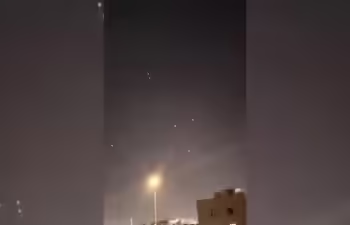The ceasefire, brokered with help from Qatar and senior U.S. officials, begins with a 12-hour halt by Iran, followed by Israel. Yet explosions in Tehran and continued IDF alerts cast doubt on the truce’s durability.
BY PC Bureau
June 24, 2025 —
A fragile ceasefire between Israel and Iran, announced by U.S. President Donald Trump just four hours ago, appeared on the verge of collapse as Iran launched a fresh wave of missiles toward Israel, triggering air raid sirens across the country at approximately 8:00 AM local time. The Israel Defense Forces (IDF) confirmed the attack, stating that its air defense systems were actively intercepting the incoming projectiles, though no immediate casualties or damage were reported.
The truce, brokered by the U.S. with Qatar’s mediation, was intended as a phased pause in hostilities following a 12-day conflict that saw Israeli airstrikes devastate Iranian nuclear facilities and Iran retaliate with missile barrages on U.S. and Israeli targets, including a strike on the U.S. Al Udeid Air Base in Qatar. Trump’s announcement, made via his Truth Social platform late Monday, declared a “complete and total ceasefire” set to begin at midnight EDT Tuesday, with Iran halting attacks for 12 hours, followed by Israel, culminating in an official end to the “12 Day War” by midnight EDT Wednesday.
Iran’s Response: From Denial to Conditional Consent
Initially, Iranian Foreign Minister Abbas Araghchi denied any agreement had been reached. “As of now, there is NO ‘agreement’ on any ceasefire or cessation of military operations,” he posted on X at 4:16 a.m. Tehran time. However, he added a significant caveat: if Israel ceased its “illegal aggression” by 4 a.m. Tehran time (8:30 p.m. EDT Monday), Iran had “no intention to continue our response afterwards.”
His remarks hinted at a shift, following reports from a senior Iranian official to Reuters that Tehran had accepted a U.S.-proposed, Qatar-mediated ceasefire. Later, Araghchi praised Iran’s military for retaliating until “the very last minute,” underscoring that Iran’s commitment to the truce hinged on Israel halting its airstrikes.
Neither Israel nor Iran has released official details of the agreement, fueling skepticism about its durability. Analysts, including Middle East expert Omar Rahman on Al Jazeera, warn that the lack of transparency, coupled with continued military readiness—evidenced by Israel’s evacuation warnings in Tehran and Iran’s missile salvos—could unravel the truce.
Despite this, Iranian missile launches resumed, and the IDF reported ongoing strikes in Tehran, suggesting both sides continued “final missions” permitted under the ceasefire’s vague terms.
READ: Big Win for Tribals: Adani Plant Out of Kokrajhar?
Despite the announcement, explosions were reported in Tehran, and the Israel Defense Forces (IDF) issued evacuation warnings in parts of the country, indicating continued military activity as both sides wrapped up what were described as “final missions.”
President Trump announces that Israel and Iran have agreed to a ceasefire “in approximately six hours from now.”
“Officially, Iran will start the CEASEFIRE and, upon the 12th Hour, Israel will start the CEASEFIRE and, upon the 24th Hour, an Official END to THE 12 DAY WAR will be… pic.twitter.com/5z25VHbKwK
— Kaitlan Collins (@kaitlancollins) June 23, 2025
Ceasefire Framework and Diplomatic Channels
A senior White House official stated the ceasefire hinges on a strict tit-for-tat cessation of attacks: Iran must initiate the pause, and Israel will reciprocate if no further strikes occur. The agreement emerged from urgent diplomatic engagement—Trump reportedly spoke directly with Israeli Prime Minister Benjamin Netanyahu, while Vice President JD Vance, Secretary of State Marco Rubio, and Special Envoy Steve Witkoff maintained contact with Iranian intermediaries.
Qatar’s Prime Minister Sheikh Mohammed bin Abdulrahman Al Thani played a central role, reportedly securing Tehran’s assent in a call following Iran’s missile attack on Al Udeid.
The conflict began on June 13, when Israel struck suspected Iranian nuclear and military sites, citing intelligence that Tehran was fast-tracking nuclear weapons development—a claim Iran strongly denies. The U.S. entered the fray on June 21, with B-2 bombers hitting three Iranian nuclear facilities, including the fortified Fordow site. Iran retaliated with missile salvos targeting Israel and the U.S. base in Qatar, although Trump downplayed the latter, calling it “very weak” and noting Iran gave prior warning, resulting in no casualties.
READ: Kuki Rights Body Accuses Biren Singh of Weaponizing History
Markets React as Doubts Persist
Markets responded positively to the truce: S&P 500 futures rose 0.4%, and Brent crude fell 4% to just above $68 per barrel. However, skepticism remains high. Neither Israel nor Iran has officially confirmed the ceasefire, and the IDF continues to operate under heightened alert.
Analysts warn that while the truce is a possible turning point, its success is far from guaranteed. Explosions in Tehran and continued Israeli warnings suggest both sides are hedging their bets. The truce also sidesteps the core issue—Iran’s nuclear program. IAEA chief Rafael Grossi noted it is too early to assess the extent of damage to Fordow, and Iran has not signaled any shift in its nuclear posture.
Middle East analyst Omar Rahman told Al Jazeera the lack of clear terms and the continued military action may complicate enforcement. Trump’s optimistic prediction of a “forever” ceasefire contrasts with prior Israeli statements suggesting readiness for a prolonged campaign, and Tehran’s confidence in its nuclear resilience.
A Fragile Pause or a Lasting Peace?
As the world watches, the ceasefire remains fragile. Whether it holds or collapses depends on mutual restraint and political will in Washington, Tel Aviv, and Tehran. For now, the guns may fall silent, but the underlying tensions remain unresolved.













